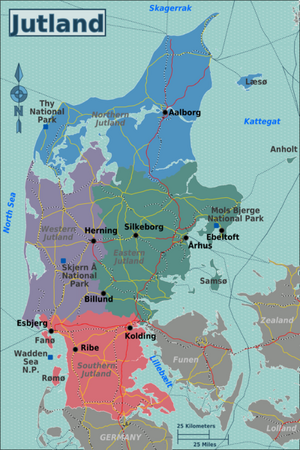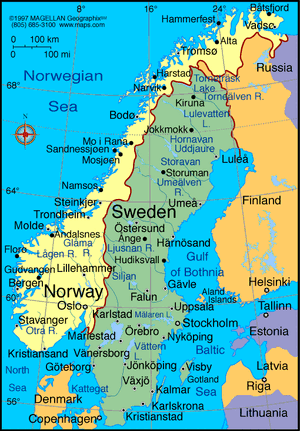Kattegat
| Author:Laxman Burdak, IFS (R) |

Kattegat (Danish) or Kattegatt (Swedish) is a 30,000 km2 sea area bounded by the Jutland Peninsula in the west, the Straits islands of Denmark to the south and the provinces of Västergötland, Scania, Halland and Bohuslän in Sweden in the east. The Baltic Sea drains into the Kattegat through the Danish Straits. The sea area is a continuation of the Skagerrak and may be seen as a bay of the North Sea, a bay of the Baltic Sea or—as in traditional Scandinavian usage—neither of these.
According to the definition established in a 1932 convention signed by Denmark, Norway and Sweden, the northern boundary between the Kattegat and Skagerrak is found at the northernmost point of Skagen on Jutland, while the southern boundary towards Øresund is found at the tip of Kullen Peninsula in Scania.[1]
Waterways that drain into the Kattegat are the rivers of Göta älv at Gothenburg, together with the Lagan, Nissan, Ätran and Viskan in the province of Halland on the Swedish side, and the river of Gudenå in Jutland, in Denmark.
The main islands of the Kattegat are Samsø, Læsø and Anholt; the latter two, due to their dry summer climate, are referred to as the Danish desert belt.
Etymology
According to Den Store Danske Encyklopædi and Nudansk Ordbog, the name derives from the Dutch words kat (cat) and gat (hole, gate). It derives from late medieval navigation jargon, in which captains of the Hanseatic trading fleets would compare the Danish Straits to a hole so narrow that even a cat would have difficulty squeezing its way through, on account of the many reefs and shallow waters.[2] [3]At one point, the passable waters were a mere 3.84 kilometers wide. The name of the Copenhagen street Kattesundet has a comparable etymological meaning, namely "narrow passage".[4]
An archaic name for both the Skagerrak and Kattegat was the Norwegian Sea or Jutland Sea (Knýtlinga saga mentions the name Jótlandshaf). Its ancient Latin name was Sinus Codanus.[5]
External links
References
- ↑ Convention No 3210. League of Nations Treaty Series 139, 1933–1934. Retrieved 27 December 2012.
- ↑ "Limits of Oceans and Seas" (3rd ed.). International Hydrographic Organization. 1953.
- ↑ Nudansk Ordbog (1993), 15th edition, 2nd reprint, Copenhagen: Politikens Forlag, entry Kattegat
- ↑ Nudansk Ordbog (1993), 15th edition, 2nd reprint, Copenhagen: Politikens Forlag, entry Kattegat
- ↑ Nudansk Ordbog (1993), 15th edition, 2nd reprint, Copenhagen: Politikens Forlag, entry Kattegat
